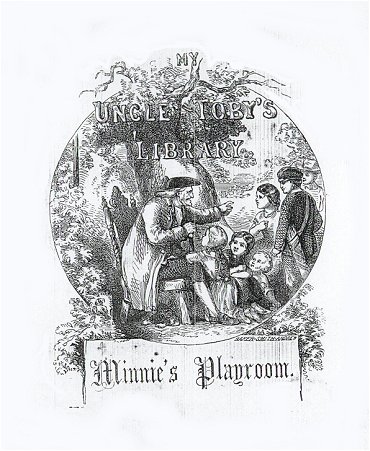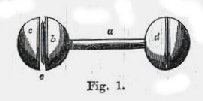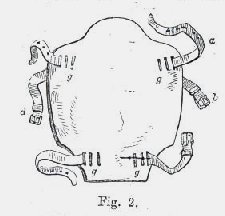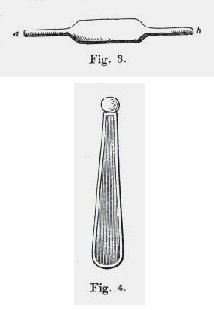Minnie's Playroom;
or,How to Practice Calisthenics
by
Francis Forrester, Esq.
Author of "Cousin Nelly," "Fretful Lillia," Etc.
---~~~~~~~---
Boston:
Geo C. Rand, 3 Cornhill.
Wm. J. Reynolds & Co. 1854

[c1853 by Daniel Wise]

Entered, according to Act of Congress, in the year 1853, by
| |
| [5] |
MINNIE'S PLAYROOM------ "PA," said Minnie Brown one day to her father, who was seated on the sofa, reading -- "pa, here's one of the cutest stories I've read for a long time." "What is it, my child?" asked. Mr. Brown, laying down his paper and looking kindly at his daughter. Minnie stepped to her father's side, and, showing him a book she held in her hand, said, -- |
| [6] |

"See, pa, here is a picture of King George the Third, of England, with his queen and two of his children. And what do you think that Quaker lady's little boy is doing?" "He appears to be saying something good, for the king looks mightily pleased." "He is reciting a poem about peace, pa." |
| [7] |
"Reciting a poem? How came he to get into the royal presence?"
"Why, you see, his mother was employed in the palace to sew for the queen, who was quite partial to her; so one day she requested her majesty to hear her son George recite a few verses before the royal family. The queen was pleased to consent; and then the little fellow stood up boldly, and spoke his poem in brave style. "Are the verses pretty? Suppose you read them to me --" "I think they are very simple; but I will read them, pa." Then Minnie read the poem, in which |
| [8] |
the little fellow tells the king that though he would not fight for him, yet he would love him, and be a good subject. The piece closed thus: --
"Yet I will serve my prince as years increase, And cultivate the finest arts of PEACE. As loyal subjects, then, great George, by thee, Let genuine Quakers still protected be." "Bravo, Quaker George was true to his cloth, and he taught King George a good lesson. I love the little boy for that, Minnie; and I hope you will learn from him to be always true to yourself, wherever you are. As he talked like a brave young Quaker to a king, so do you talk and act like a Christian, my child, before all." |
| [9] |
"I will try, pa."
"And now, my child," said Mr. Brown, as he rose to his feet, "I am going to explain my secret to you. Put on your bonnet and come with me." "You are, pa? O, thank you," cried Minnie, clapping her hands and getting ready to follow her father. This secret related to a room in the rear of the house, which Mr. Brown had been fixing up in a mysterious way. He had carefully kept his daughter from seeing it; only he had told her there was a secret about it, which she should have made plain to her at the proper time. He had done this to teach her to repress |
| [10] |
her curiosity. But now the matter was to be made plain.
Jumping and skipping, with a step light as a gazelle's, Minnie followed her father to the mystic room. On entering it, she found it nicely fitted up with shelves, swings, seats, and tables. Over a window at the farther end, she saw, printed in large letters, the words MINNIE'S PLAYROOM. Mr. Brown was an indulgent father and a sensible man. He knew children require amusements; and, being able to afford it, he had fixed up this room for Minnie to play in when the weather was such she could not play out of doors. |
| [11] |
Minnie was taken by surprise. She had not looked for such indulgence. Her warm heart glowed with grateful love as she viewed the room, and, after a few moments of silent wonder, she sprang into her father's arms, and said, --
"Dear father, how very, very kind you are!" As soon as Minnie grew calm again, her father took her round the room to show her what he had done. In one place he had put shelves for her books; in another, drawers for her playthings; in a third spot she found a work table; in a fourth, a tea table. From the |
| [12] |
beams there hung two swings; and in one corner there was a heap of things, the use of which Minnie did not know. Turning to her father, she asked, --
"Pa, what are these funny things for?" 
"They are to help you to play CALISTHENICS. I will tell you their names, and you will learn how to use them hereafter. Here are the dumb-bells--" and Mr. Brown took up one of them as he spoke. (Fig. 1) "I had them made to suit myself. This part (a) is called the shaft. It is six |
| [13] |
inches long, and is made of oak. These globes are made of two halves or hemispheres (c b) screwed together, (e,) so that they can be taken apart, and loaded with peas, shot, bullets, or sand."
"Loaded with bullets, pa? How funny! But what for?" "Yes, Minnie, they are loaded or filled to make them the right weight. A dumb-bell for you must not weigh over two pounds; for Arthur Ellerslie, three pounds would be the right weight." "What is this thing with straps?" (Fig. 2) "This is called a short backboard. |
| [14] |
 It is fitted with straps to fasten it to the back and shoulders, (a b c d .)
These holes (g g g g) are cut in it, so that the straps can be made longer or shorter, to suit the wearer." *
It is fitted with straps to fasten it to the back and shoulders, (a b c d .)
These holes (g g g g) are cut in it, so that the straps can be made longer or shorter, to suit the wearer." *
"But what is this flat board?" (Fig. 3) "This is called a long backboard. The flat part is to reach across the back -------- * The short backboard is usually twelve or thirteen inches in length, ten inches in breadth, the lower part five inches, and the upper part four inches: the size depends on the age of the child. |
| [15] |
 of the shoulders, and the handles (a b) are made long enough to hold in the hands when the arms are spread out.
of the shoulders, and the handles (a b) are made long enough to hold in the hands when the arms are spread out.
"But here is something I should call a club, pa." (Fig. 4) "Yes, this is a club, Minnie. It is hollow.* The ball on the top screws |